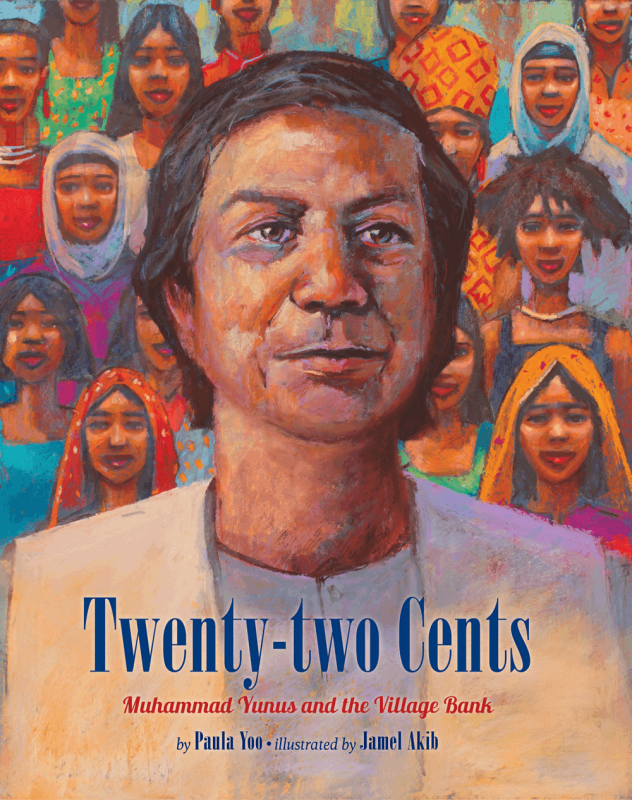21 Oct / Twenty-two Cents: Muhammad Yunus and the Village Bank by Paula Yoo, illustrated by Jamel Akib

 Even as a child, Muhammad Yunus recognized inequity: a story of an 8-year-old Yunus giving his meal to a hungry woman and her daughter opens multi-media author/screenwriter/television producer Paula Yoo’s latest picture book. Into this inspiring biography of the Nobel Peace Prize-winning contemporary hero, Yoo also manages to weave a just-right-for-young-readers introduction to economics, social justice, world peace, investment in women, and the transforming power of just 22 cents. Yes, all that and more is here – gorgeously, sweepingly illustrated by British Malaysian artist Jamel Akib.
Even as a child, Muhammad Yunus recognized inequity: a story of an 8-year-old Yunus giving his meal to a hungry woman and her daughter opens multi-media author/screenwriter/television producer Paula Yoo’s latest picture book. Into this inspiring biography of the Nobel Peace Prize-winning contemporary hero, Yoo also manages to weave a just-right-for-young-readers introduction to economics, social justice, world peace, investment in women, and the transforming power of just 22 cents. Yes, all that and more is here – gorgeously, sweepingly illustrated by British Malaysian artist Jamel Akib.
Born in Chittagong in what was still India in 1940, Yunus learned the value of education from his parents. His jeweler father had finished only the eighth grade, his mother only fourth, but both encouraged and enabled their children to go to college and explore the world. Yunus took those lessons to heart, studying economics at Dhaka University, then continuing his education on a Fulbright in the United States. He chanted for peace in Washington, DC when his homeland declared independence to become the country of Bangladesh. Amidst post-war drought and famine, he returned home to head the Economics Department at Chittagong University.
Yunus practiced charity early, but he realized that handouts could never break the cycle of poverty. He met a young woman, Sufiya, weakened by the lack of food, but endowed with skillful artistry; a local moneylender kept her trapped with high interest rates and unfair practices. Just 22 cents could free her of her crippling daily debt and allow her to support her family. Sufiya was just one of many, many women fighting for her family’s lives.
Yunus devised a plan, but he quickly learned how unwilling banks were to invest in poor women. So he started his own, one that would provide amounts so seemingly insignificant to some, but lifesaving to many more. Grameen Bank, founded in 1977, meant “village bank” and would become an international phenomenon, creating the empowering economic model known as “microcredit.” Yunus would become renowned as the Banker to the Poor.
Grameen and Yunus together were recognized in 2006 with the Nobel Peace Prize for proving that “”even the poorest of the poor can bring about their own development.'” Especially the women: of the $10 billion-plus microcredit loans Grameen has provided to almost 12 million people worldwide, 94% of those borrowers are women. Those women were at the center of Yunus’ Nobel acceptance speech: “‘This year’s prize gives highest honour and dignity to the hundreds of millions of women all around the world who struggle every day to make a living and bring hope for a better life for their children. This is a historic moment for them.'”
Yoo and Akib have created a most child-friendly tool to teach that empowering history to our youngest readers. Just open the pages and let the empowerment continue …
Readers: Children
Published: 2014
